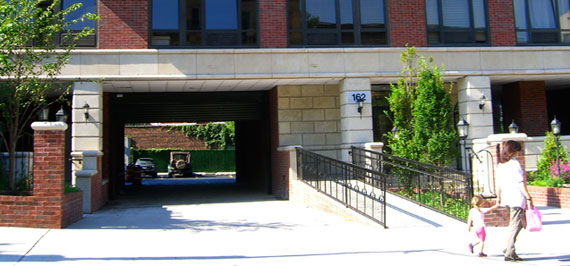The Parking Cure, Step 1: Diagnose the Problem

This curb-cutting driveway leads to a parking lot for a new residential development on 16th Street in Brooklyn.
What would you do if you went to the doctor, and before speaking to you, taking your vital signs, or learning about your condition, she prescribed a powerful drug and kicked you out the door?
New York City’s land-use doctor is the City Planning Commission, and the drug it doles out is the Zoning Resolution, a 1960s-era set of laws that is gradually transforming swaths of the city into more suburban, car oriented environments.
City zoning requires substantial parking at all new residential buildings. In many neighborhoods that means an astoundingly higher level of parking. For instance, the Zoning Resolution requires new residential buildings in walkable Park Slope to have eight times more off-street parking than the existing housing stock. So what does the planning commission base its powerful prescription on? Not much, according to Suburbanizing the City [PDF], a study just released by Transportation Alternatives, the Regional Plan Association and a host of other prominent transportation and planning groups. The study projects a billion miles of new driving by 2030 due to the planning commission’s off-street parking requirements. Yet, in the recommendations accompanying the report, the groups write:
It
appears that City planners do not know how much off-street parking exists, how
much parking is planned and permitted, or how existing or planned new parking
contributes to traffic, air pollution and carbon emissions.
As a first step toward diagnosing the extent of the parking problem, the groups ask the mayor to "fully assess the amount of existing
and planned off-street parking" and take the following actions to accomplish that:
- Inventory existing and planned off-street
parking.
The City should create a complete, public, inventory of existing,
permitted and planned off-street parking. Using this information, the City
should fully assess the relationship between residential, retail and
commercial parking requirements, driving and travel choice. This
information will provide a baseline to assess the impact of additional
parking. - Measure how much driving is created by new
off-street parking. City agencies do not know the impact of new parking. Neither
the Department of City Planning nor the Department of Transportation have computer
models, surveys, sampling or studies that reveal the local or cumulative
impact of parking requirements. - Determine parking demand based on the
assumption that off-street parking has a cost. Currently, the Department of City Planning and
environmental documents project demand for parking based on the assumption
that it is free. This results in very high demand assumptions. The City
should estimate demand for off-street parking based on appropriate price
levels. - Measure the effect of increases in parking
growth on neighborhood and citywide traffic congestion. Through permits and as
of right building, the City is increasing the city’s off-street parking
supply, while the capacity of the street network remains static. New traffic as a result of new cars on
the road (facilitated by the availability of parking) must be closely
analyzed.
Given the mayor’s sustainability push and the highly-touted PlaNYC, it seems logical that the City Planning Commission would take a careful look at Robert Moses-era, driving-inducing parking requirements. But old habits die hard. Ask the doctors. For hundreds of years they tried to cure the common cold by bleeding the patient. For some, the cold went away; many others died.
Photo: Ben Fried





